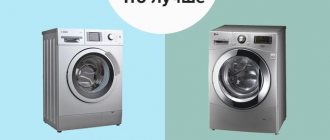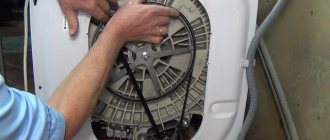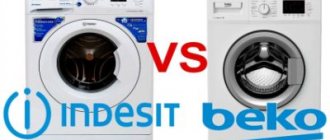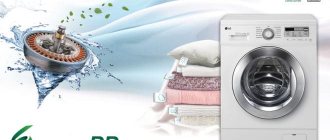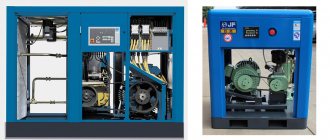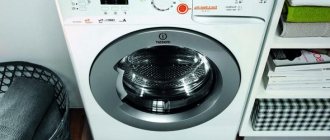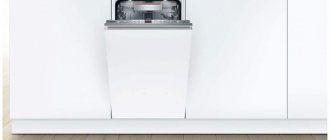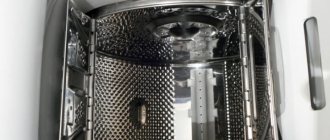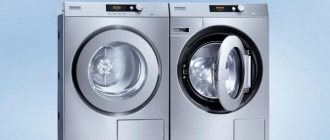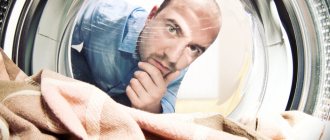The developers made sure that there are many top-loading and mechanically controlled models on the market. It is quite difficult for an unenlightened person to choose a suitable unit. Indeed, currently manufacturers of the most popular brands Bosch, Beko and Indesit offer machines with similar mechanical control functionality, and in the same price range.
Selecting a machine
So, the type of drum is determined. There are fewer models with a vertical arrangement than with a traditional front one, and they are less popular. This is affected by some design differences.
Price categories of washing machines - the basis of choice
If you start reading all sorts of recommendations for choosing a machine, you will come across the fact that you will be praised for various convenient functions: for example, protecting equipment from leaking, and laundry from wrinkles. The advantages of a large drum, type of load, number of spin and wash classes will also be listed. Well, and other pleasant little things that make communication with the automatic “laundress” as comfortable as possible.
All this, of course, is good, but all these wonderful functions should be discussed a little later. But we don’t need to start with this – first of all, we will determine the price segment. And it depends on the amount that you managed to save for the purchase. Because with a limit of $300 or $400, there is no point in building castles in the air while looking with enthusiasm at expensive premium models.
After all, each of the additional functions that are sung so beautifully and inspiredly in advertising usually has a significant equivalent in conventional units. Well, or in rubles, if you prefer. And what’s the point of arguing about which brand of washing machine is better if the means allow you to look only towards the lowest price niche.
After all, just imagine that a two hundred dollar machine produced by Indesit or Samsung would be considered the best. Then everyone would buy only these models, and well-off buyers would be no exception - and they do not want to overpay. However, this only happens in fairy tales - the above-mentioned devices are often criticized on forums, and reviews about them are not always positive.
What to do - in the world of washing machines there are also “kings”, but there are also simpler products that are not always distinguished by their luxurious appearance and durability.
If we compare it with the world of real cars, we can draw the following parallel. Mercedes and Lincolns and small humpbacked Cossacks ride peacefully around the city. And every car has its fans. It’s the same with washing machines - some prefer the simplest model, designed only to wash and spin, but for others the whole range of various functions is important.
People are different, and everyone has their own price requirements, often determined by their own income. Washing machines, according to price categories, are budget, mid-class and premium.
Choosing the best washing machine manufacturer depending on the price segment
#1. Quite cheap.
As a rule, manufacturers of the cheapest cars try to save on everything. However, they care about convenience, beautiful design and simplicity. So there is no point in looking for an abundance of various “bells and whistles” and functions in such models. There are minimal washing and spinning programs, and parts are sometimes made of not the highest quality material. And this, in turn, greatly affects the life of the product. Basically they last for five years, and sometimes they last only four years.
Well, yes, Indesit, originally from Italy, worked longer, but now a cheap machine will not last ten years. The main brands producing machines in this category are: Samsung, LG, Ariston, Beko, Siltal, Candy, Ardo, Indesit. Prices: up to 300-350 dollars.
#2. A little more expensive, but much more convenient.
The average price niche includes devices that can last much more than five years. Seven or even nine years are allotted to them to please their owners. And not only a long life, but also a solid number of spin and wash programs, as well as various pleasant additional functions. Using such a machine is undoubtedly more convenient than a budget option.
It also plays a role that most colleagues, neighbors and relatives also have something from this category. And in a conversation, you can casually drop a couple of phrases of praise about your laundry assistant. For example, talk about how comfortable it is to use the AquaStop function.
If we name specific manufacturers, then these are Gorenje, Siemens, Zanussi, Bosch, Electrolux, Whirlpool, Kaiser. Washing machines in the mid-price category range from $400 to $600. As you can see, the difference with cheap options is not so great, but the functionality is significantly increased. Therefore, those who are not very limited in funds should not think long about which brand of washing machine is better to buy. This level of units is precisely for this category of buyers.
#3. Quite expensive, but extremely convenient.
A maximum of all possible functions, modes and washing programs, maximum care for the buyer - this is what premium products are. At the same time, they are distinguished by amazing durability coupled with a careful and careful attitude towards linen. Here, for example, is what creative advertisers came up with to present a high-end Aeg brand car. They took a bouquet of roses and washed them at 1600 rpm on a gentle cycle. After being pulled out of the drum, the roses only became refreshed - not a single leaf or petal fell from them. Miracles, and that’s all!
In this expensive price category (from 800 to 2000 dollars) the choice of brands is very small. This is the already mentioned Aeg concern, as well as Miele. However, this also includes laundry complexes made according to the American type. These brands are GE, Amana, Frigidaire, Maytag. They are hardy and reliable - they work for a solid “five” for ten, fifteen or more years.
However, one owner of a Miele machine named Alexzz claims on the Internet that it has served him faithfully for thirty years. And it washes everything just as perfectly as it did when it was brand new.
Here it is also worth mentioning not machines, but entire “laundries”. Wash them even ten times a day - they will still last a long time. However, for such beauty you will have to pay a lot of euros - from 2500 to 3000. However, there are exceptions - for example, there are thousand-dollar cars from Samsung and five-hundred-dollar cars from Bosch. But still, their main specialization is the middle segment for the Bosch brand and the lower segment for Samsung and the like. Therefore, you should not chase such exceptions - it is better to buy a car from the class from which you were going.
Well, now let's rank all the manufacturers, first naming the best, and at the end - the lowest category.
Aeg, Miele and American-style Laundry complexes. Price: from 800 to 3000 USD. e.
Whirlpool, Kaiser, Gorenje, Bosch, Electrolux, Siemens, Zanussi. Price: from 400 to 600 USD. e.
LG, Ariston, Beko, Candy, Ardo, Indesit, Samsung, Siltal. Price: from 300 to 350 USD. e.
Types of semi-automatic machines
Unlike automatic washing devices, semi-automatic machines cannot operate without the participation of a person who must pour and drain water and transfer laundry for spinning. On the one hand, this creates some problems, but on the other, it has certain advantages.
In specialized stores you can find a variety of models of semi-automatic devices that differ in design, size, capacity, and additional functions.
Based on various criteria, we can distinguish a number of varieties of semi-automatic washing machines. Each category has distinctive qualities.
Activator and drum models
Based on the mode of action, there are activator and drum types. In the first case, a special device is installed at the bottom of the container - an activator, with the help of which the laundry is rotated in the internal space of the container.
More than 90% of modern semi-automatic machines fall into this category, which is explained by the high advantages of such equipment. Due to the compactness of the operating unit, such machines are reduced in size and light in weight. The simple mechanism ensures stable operation and durability.
In activator machines, laundry is washed using a special disk that can rotate in one direction or produce reverse reverse movements.
An important advantage of activator rotation is that it is more gentle on fabric fibers when washing. Thanks to this, the products wear out less and retain their original appearance longer. This especially applies to reverse models, in which things do not twist together.
The operating mechanism of drum machines is metal drums, similar to those used in slot machines. This type of washing equipment is less in demand: at a high cost, the devices have larger dimensions and weight, but lower capacity.
One and two bay devices
The simplest modifications of semi-automatic machines have only one compartment for linen. Such devices weigh very little, but they are less functional, since things have to be squeezed out manually. Cars with two compartments are more convenient. Their design involves two tanks, in one of which the laundry is washed and rinsed, and in the other - spinning.
When transferring products from one compartment to the second, you should try to distribute them evenly in the space of the centrifuge. This allows you to increase the efficiency of the moisture removal process
Choosing the best and most convenient washing machine design
Structurally, all washing machines can be divided into vertical and front loading machines.
Those models with vertical loading have their own convenient feature - laundry can be loaded into the drum directly during washing. This is a great help if you forgot to put something in right away. In addition, one of the drum sectors can be removed to remove, for example, a stuck small object.
Machine with vertical loading of laundry.
Although front-loading machines do not have such a function, they do have their advantages - a large drum. You can wash a large batch of laundry or very large items (blankets, outerwear) at once. In addition, if the laundry in such a drum is spacious, it will wrinkle less.
Machine with horizontal loading of laundry.
You can come across arguments that top-loading machines wash clothes better than horizontal-loading machines, but in fact, these are all the machinations of marketers and these machines do not have any advantages in terms of washing quality.
Another difference is that you can choose a free-standing model or a built-in one. Lately, many have been tempted by the latter option. This allows you to make the machine completely invisible - it will fit well into any interior. However, free-standing models can also be hidden under the tabletop - to do this you will have to remove the top cover. This is usually done in the kitchen, covering both the machine and the adjacent floor cabinets with a common long surface.
Washing machine built into kitchen cabinets.
There are specially sized machines that allow you to place them under the sink.
Drying can also be provided in washing units. This mechanism consists of a heating element and a fan that supplies a stream of hot air to the laundry. Fabrics are different, so some dry faster, others take longer. To ensure that things are evenly heated from all sides, the drum rotates quietly at this time - first in one direction, then in the other.
There are models where the drying mode can be set. It is possible to dry the item completely in at least half an hour. However, remember that a machine equipped with a drying mechanism will cost more and will consume more electricity. There should be less laundry to dry than during washing. You can find out whether it has dried out by using such a parameter as residual moisture.
Advantages and disadvantages of manual machines
Like any other device, a manual washing machine is endowed with positive and negative qualities.
The advantages of such devices include:
- compactness – thanks to their small size, such devices are convenient to carry and even take with you on hikes,
- autonomous operation, no need to connect the product to communications,
- significant savings in water (the process of washing clothes requires no more than 5 liters) and electricity (water is supplied hot to the machine drum),
- acceleration of the washing process - there is no need to heat the water and the washing process can be stopped at any time,
- it is possible to place things in the machine directly during the washing process,
- gentle washing - thanks to manual control, the drum does not accelerate to high speeds,
- affordable price - the cost is several times lower than that of the most budget washing machines,
- no vibration.
Flaws:
- increased noise,
- low quality of washing compared to automatic machines,
- there is no way to remove heavy stains on the fabric,
- significant expenditure of effort and time, since pouring water, rinsing and spinning require effort,
- difficulties with repairs (fortunately, they are not required often),
- small load of laundry (usually no more than 2.5 kg at a time - depending on the model),
- During the washing process, you need to be close to the machine - turn the handle or press the pedal.
Before purchasing a manual washing machine, you should consider all the positive and negative qualities of these devices. Most often they are used in camping conditions, as well as at dachas, where it is not possible to connect the machine to electricity or water supply.
Which is better: a mechanical or electronically controlled washing machine?
The mechanical control of the machine means that you will have to set all the necessary modes with your own hands. Each of the mechanical switches is responsible for its own section: one for selecting the temperature, another for the spin speed, and the third for the washing program. In addition, there are a number of control keys.
When selecting a washing program, you can use the prompts - they are usually shown next to the switch in the form of icons. And during washing, you can visually determine which stage of the program is currently taking place. Mechanical control is easier for users (especially those not accustomed to sophisticated control systems), but less functional.
Example of a mechanical control system.
Electronic control may be more difficult for certain user groups. But the clever machine will not ask for your help - it will do everything itself. He will weigh the loaded laundry, pour in as much water as needed, pour out powder, and calculate the washing time. She will also analyze what fabric the things are made of and how dirty they are. Depending on this, she will make a verdict: how much water is needed (and what temperature it should be), how long your wash will last, how many times you will have to rinse the laundry.
While such a device is operating, you will be able to see on the color display data about the water temperature, the speed of rotation of the drum during the spin cycle, as well as how much time is left to wash. If you put the laundry in not very carefully and unevenly, the electronic control will correct this mistake - it will not allow the drum to rotate too quickly. After all, there are many sensors installed in such a machine - they report on the hardness, temperature and transparency of the water, the quality of the rinse and other parameters.
If suddenly too much foam has formed or the water is suddenly turned off, the machine will turn off itself. But, unfortunately, electronic control also has a drawback - it does not like voltages other than the nominal 220 volts. In such networks it may not work properly, or even deteriorate, burning out.
Touch control of the washing machine.
Description of the device
Most experts argue that a manual washing machine is a modern device that works without connecting to communications, because the washing process in it is carried out mechanically.
And even if there is a power outage, the laundry will not be locked in the drum and can be easily taken out of the machine.
Washing in manual machines occurs using a whirlwind of water, and some models have the ability to rinse and spin clothes.
There are several varieties of this device:
- some have blades, with the help of rotation of which the process is carried out,
- in others, an air bubble effect is created that promotes washing.
All models are united by vertical loading of things.
Some people include activator-type models in the section of manual washing devices, since the entire process in them cannot occur without manual control. To better remove dirt from things, a “manual” powder with low foaming is used.
Which washing machine tanks and drums are the most reliable?
Now, more and more often, you can see cars with polymer tanks in stores. They are light and beautiful, dampen noise well and reduce vibration, and do not corrode. You can also note their good thermal insulation properties. However, such a tank can be accidentally damaged if handled carelessly - unfortunately, plastic is a rather fragile material.
A plastic tank and a stainless steel drum can often be found in cars in the low price segment.
But the good old stainless steel has surpassed it in this regard. As for the shape, the drum may not always be round. For example, an oval shape is even better than a round one - it will hold more water without coming into contact with the laundry.
Now about the drums. They are never made of plastic - they are always made of stainless steel. The drum, which has asymmetrical grips, is very convenient and well designed. This allows it to work in three planes, thanks to which the laundry is washed more efficiently.
Why did old mechanical machines last longer?
Old mechanical washing machines last longer than their modern counterparts - that's a fact. But the point is not in mechanics and electronics, but in mass production and market conditions. The first washing machines took a long time to produce, were made for quality and were expensive. The machines were assembled from strong parts under strict control and constant testing. They did not skimp on materials: the tank was made of stainless steel, the counterweights were made of cast iron, and the body was made of expensive plastic. As a result, the consumer received a wear-resistant “home assistant” for a tidy sum.
Now competition is forcing manufacturers to reduce costs and speed up production. Washing machines are checked not by people, but by robots; the cheapest materials, concrete counterweights and plastic tanks are used. Even the body is made of thin plastic - all to reduce costs. Mass production also makes its contribution: more equipment is assembled, and the percentage of defects increases. But modern washing machines cost several times less than their “ancestors”: the average price is 10-12 thousand. If such a unit lasts even 3 years, it will “recoup” its cost in full.
Interesting:
- Manual washing machine review
- How to choose a brand of washing machine?
- Rating: 5 Best Washer and Dryer Sets
- How to choose an industrial washing machine?
- What is better washing machine Indesit or Beko?
- What load is the washing machine best with?
1 reader comment
- 05.10.2021 at 02:04
Anonymous:
How to remove music? Impossible to listen!
Answer
How to evaluate the efficiency of a washing machine
At the very beginning of 1995, Europe decided to standardize the parameters for comparing washing machines, calling them “EEC criteria”. With these criteria, it has become much easier to determine which washing machine washes clothes better. Since then, a special insert with these ratings, assigned according to an accepted scale, has been placed inside each machine. These are the first seven letters of the Latin alphabet - from A to G. If compared with the school grading system, they mean the following:
Explanation of ratings:
- A – five points;
- B – four plus;
- C – four points;
- D – four with a minus (average, or normal);
- E – three points;
- F – two points;
- G – unit.
Explanation of symbols:
- Type of product;
- Manufacturers;
- Model;
- Energy class;
- Energy consumption kW/h;
- Energy efficiency class;
- Spin efficiency class;
- The maximum possible rotation speed of the drum during spinning, rpm;
- Nominal drum load with laundry, (kg);
- Water consumption, per wash cycle, (l.);
- Noise level during washing, (db.);
- Noise level during spinning, (db.).
Now let’s go through the specific parameters that are reflected in this insert.
Power level
To determine the level of power consumed by the device, take the power consumption for one wash of hard laundry and a temperature of 60 degrees. There are 7 classes here - all the same letters from A to G.
Washing and spinning efficiency
Exactly the same letters indicate both washing efficiency and spin efficiency. It should be noted that for the last parameter it is better to choose models of classes C and D. By the way, when spinning, the main thing is not always the number of revolutions. This is important, but no less important is how long it takes to spin the laundry. And the size of the drum also plays a role. Choose from two similar models with the same speed a device with a larger drum. If they have the same drums, then look at the spin time - the longer it is, the better.
And one more thing: the machine reaches maximum speed during the spin cycle only at the end of the spin cycle. Cheap machines work at this maximum for 30 seconds, no more. Models with a higher price can spin at maximum speed for a couple of minutes, and very expensive machines can do four minutes. So, it is better to choose a device not based on the maximum spin speed, but on another indicator - the residual degree of moisture in the laundry.
Amount of water
The amount of water required for one wash (in other words, water consumption) is an important parameter. Both electricity consumption and the amount of washing powder depend on it.
Noise level
The noise level will show how comfortable it will be for others during washing and spinning. However, not all manufacturers want to advertise this characteristic. But some figures can be given as an example: in particular, 43 decibels of noise is one of the best indicators that some AEG models have. The noise level of SIEMENS WM 71630 is slightly higher - 47 decibels.
What types of manual machines are there?
There are several types of machines designed for washing by hand:
- Activator . In comparison with an automatic machine, an activator-type device does not have a water connection, so warm water is supplied manually. However, for such a device to operate, it must be connected to an electrical outlet. Manual control allows washing to be carried out until the person himself disconnects the device from the network.
Often, activator-type machines have 2 working compartments - for washing clothes and rinsing, and the laundry is transferred from one to another independently. The main features of such devices are reliability and unpretentiousness, thanks to which they are sure to last for several years if they are used correctly. That is why activator devices are in great demand among summer residents and pensioners.
- Foot device. This is a miniature device that resembles a barrel in appearance. Such a device does not need to be connected to a water supply or other communications, and the washing process occurs when you press the pedal. To get started, you need to put things in the drum, fill it with water, and then add any powder. Some types of foot-operated machines are capable of not only washing, but also rinsing clothes and even wringing them out.
- Hand washing machine. The design and principle of operation of this device resembles a foot-operated device, only the washing process occurs by turning the handle (like on a sewing machine).
When choosing a device, you need to carefully familiarize yourself with its types and characteristics, after which you will be able to make the right choice.
Additional features desirable for a good washing machine
Your smart laundry assistant should be fast and economical without using up too much powder, water or electricity. To achieve this, manufacturers equip their products with convenient functions. To decide for yourself which automatic washing machine is better, remember some useful programs and modes that are desirable for a good washing machine.
- The presence of the “Delayed Start” function will save energy.
- The “Easy Ironing” function is very good, which includes a special phase of the mode at intervals.
- Some machines have a “Hand Wash Wool” function. This will not allow your favorite sweaters to stretch out or shrink - the drum in this mode moves very smoothly, in a special rhythm.
- The “Accelerated Wash” program allows the machine to wash your laundry in half an hour - and the entire cycle will be complete.
- If your device has the “Additional load of laundry” function, then the wash can be interrupted by adding new items to the tank.
- On vertical type machines, a feature called “Automatic Drum Lock” is required. Then the hatch is always opposite the loading window.
- Well, the “Aqua-Stop” system is very good for lazy people who don’t want to open and close the water tap connected to the washing machine every time.
How to convert a washing machine into a manual one
A semi-automatic washing machine can be converted to manual control. To do this, it is enough to include a pedal or handle in the mechanism for control. One of these developments was created in Peru.
Students from Los Angeles had to create a commercial product for the poor. After following the lives of local residents in Peru, they came to the conclusion that women spend about 6 hours a day doing laundry. Having decided to develop a washing machine, the students created a pedal-powered washing machine. Development costs $40, so even those who earn $4-10 a day will be able to afford such a machine.
The device works simply: laundry is loaded into the tank, water is poured. The lid closes on top. The woman sits on the lid and presses the pedal.
Everything ingenious is simple. If you need a simple washing machine for your dacha, you can make it following the example of college students or convert a broken washing machine into a working machine.
